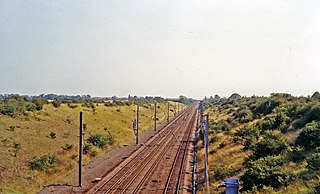The Norton Fitzwarren rail crash occurred on 4 November 1940 between Taunton and Norton Fitzwarren in the English county of Somerset, when the driver of a train misunderstood the signalling and track layout, causing him to drive the train through a set of points and off the rails at approximately 40 miles per hour (64 km/h). 27 people were killed. The locomotive involved was GWR King Class GWR 6028 King Class King George VI which was subsequently repaired and returned to service. A previous significant accident occurred here on 10 November 1890 and the Taunton train fire of 1978 was also within 2 metres.

Witham railway station is on the Great Eastern Main Line (GEML) in the East of England, serving the town of Witham, Essex. It is situated about half a mile (1 km) from the north of the town centre and is 38 miles 48 chains (62.1 km) down the line from London Liverpool Street. On the GEML, Witham is situated between Hatfield Peverel to the west and Kelvedon to the east. It is the junction for the Braintree Branch Line to the north-west, which opened in 1848; between 1848 and 1964, it was also the junction for a south-east-facing branch line to Maldon. Its three-letter station code is WTM.

The Harrow and Wealdstone rail crash was a three-train collision at Harrow and Wealdstone station in Wealdstone, Middlesex during the morning rush hour of 8 October 1952. The crash resulted in 112 deaths and 340 injuries, 88 of these being detained in hospital. It remains the worst peacetime rail crash in British history and the second deadliest overall after the Quintinshill rail disaster of 1915.

Over the latter years of the 19th and early years of the 20th centuries, Penistone in Yorkshire gained a name as an accident black-spot on Britain's railway network; indeed, it could be said to hold the title of the worst accident black-spot in the country. The main line through the town was the Woodhead route of the Manchester, Sheffield and Lincolnshire Railway between Sheffield Victoria and Manchester, London Road. The line was heavily graded with a summit some 400 yards inside the eastern portal of the Woodhead tunnel.
The Eltham Well Hall rail crash was an accident on the British railway system that occurred on 11 June 1972 at approximately 21:35. An excursion train from Margate to Kentish Town derailed on a sharp curve at Eltham Well Hall station, Eltham, London. The curve had a maximum permitted speed to be taken at 20 miles per hour (32 km/h) but the train was estimated to have been travelling at 65 miles per hour (105 km/h) resulting in the locomotive and all but one of the ten carriages derailing.

The Thorpe rail accident occurred on 10 September 1874 when two trains were involved in a head-on collision near Thorpe St Andrew, Norfolk, England.
The Glasgow and Paisley Joint Railway was the section of railway line between Glasgow Bridge Street railway station and Paisley, in the west of Scotland. It was constructed and operated jointly by two competing railway companies as the stem of their lines to Greenock and Ayr respectively, and it opened in 1840. The Joint Committee, which controlled the line, built a branch to Govan and later to Cessnock Dock, and then Prince's Dock.

The Thirsk rail crash occurred on 31 July 1967 at Thirsk, Yorkshire, England on the British Rail East Coast Main Line.

The Spa Road Junction rail crash was an accident on the British railway system which occurred during the peak evening rush hour of 8 January 1999 at Spa Road Junction in Bermondsey, in South East London.

The Abbots Ripton rail disaster occurred on 21 January 1876 at Abbots Ripton, then in the county of Huntingdonshire, England, on the Great Northern Railway main line, previously thought to be exemplary for railway safety. In the accident, the Special Scotch Express train from Edinburgh to London was involved in a collision, during a blizzard, with a coal train. An express travelling in the other direction then ran into the wreckage. The initial accident was caused by:

The Grantham rail accident occurred on 19 September 1906. An evening Sleeping-Car and Mail train of the Great Northern Railway, running from London Kings Cross to Edinburgh Waverley hauled by Ivatt 'Atlantic' No 276 derailed, killing 14. The accident was never explained; the train ran through Grantham station, where it was scheduled to stop, and derailed on a set of points on a sharp curve at the end of the platform, which at the time had been set for a freight train. No reason was ever established as to why the train did not stop as scheduled, or obey the Caution and Danger signals.

The Wembley Central rail crash was a fatal railway accident that occurred on 11 October 1984 just outside Wembley Central railway station, Greater London.
The Milton rail crash was a crash in 1955, at Milton, Berkshire. A passenger train took a crossover too fast and derailed. Eleven people were killed, and 157 injured.
The Settle rail crash was a railway accident that occurred at Langcliffe near Settle, England, on the night of 21 January 1960 in which two trains collided, killing five people and injuring eight more.
The Slough rail accident happened on 16 June 1900 at Slough railway station on the Great Western Main Line when an express train from London Paddington to Falmouth Docks ran through two sets of signals at danger, and collided with a local train heading for Windsor & Eton Central. Five passengers were killed; 35 were seriously injured, and 90 complained of shock or minor injuries

The Stonehaven derailment was a fatal railway accident that occurred at 09:38 BST on 12 August 2020, when a passenger train returning to Aberdeen hit a landslip, near Carmont, west of Stonehaven in Aberdeenshire, Scotland, following severe rain. Of the nine people aboard, three were killed, and six were injured.










